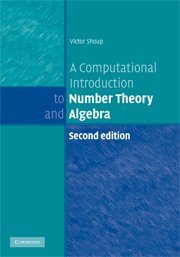Book contents
- Frontmatter
- Contents
- Preface
- Preliminaries
- 1 Basic properties of the integers
- 2 Congruences
- 3 Computing with large integers
- 4 Euclid's algorithm
- 5 The distribution of primes
- 6 Abelian groups
- 7 Rings
- 8 Finite and discrete probability distributions
- 9 Probabilistic algorithms
- 10 Probabilistic primality testing
- 11 Finding generators and discrete logarithms in ℤ*p
- 12 Quadratic reciprocity and computing modular square roots
- 13 Modules and vector spaces
- 14 Matrices
- 15 Subexponential-time discrete logarithms and factoring
- 16 More rings
- 17 Polynomial arithmetic and applications
- 18 Linearly generated sequences and applications
- 19 Finite fields
- 20 Algorithms for finite fields
- 21 Deterministic primality testing
- Appendix: Some useful facts
- Bibliography
- Index of notation
- Index
Preliminaries
Published online by Cambridge University Press: 05 February 2015
- Frontmatter
- Contents
- Preface
- Preliminaries
- 1 Basic properties of the integers
- 2 Congruences
- 3 Computing with large integers
- 4 Euclid's algorithm
- 5 The distribution of primes
- 6 Abelian groups
- 7 Rings
- 8 Finite and discrete probability distributions
- 9 Probabilistic algorithms
- 10 Probabilistic primality testing
- 11 Finding generators and discrete logarithms in ℤ*p
- 12 Quadratic reciprocity and computing modular square roots
- 13 Modules and vector spaces
- 14 Matrices
- 15 Subexponential-time discrete logarithms and factoring
- 16 More rings
- 17 Polynomial arithmetic and applications
- 18 Linearly generated sequences and applications
- 19 Finite fields
- 20 Algorithms for finite fields
- 21 Deterministic primality testing
- Appendix: Some useful facts
- Bibliography
- Index of notation
- Index
Summary
We establish here some terminology, notation, and simple facts that will be used throughout the text.
Logarithms and exponentials
We write log x for the natural logarithm of x, and logbx for the logarithm of x to the base b.
We write ex for the usual exponential function, where e ≈ 2.71828 is the base of the natural logarithm. We may also write exp[x] instead of ex.
Sets and families
We use standard set-theoretic notation: ∅ denotes the empty set; x ∈ A means that x is an element, or member, of the set A; for two sets A, B, A ⊆ B means that A is a subset of B (with A possibly equal to B), and A ⊊ B means that A is a proper subset of B (i.e., A ⊆ B but A ≠ B). Further, A ∪ B denotes the union of A and B, A ∩ B the intersection of A and B, and A \ B the set of all elements of A that are not in B. If A is a set with a finite number of elements, then we write |A| for its size, or cardinality. We use standard notation for describing sets; for example, if we define the set S ≔ {−2,−1, 0, 1, 2}, then {x2 : x ∈ S} = {0, 1, 4} and {x ∈ S : x is even} = {−2, 0, 2}.
- Type
- Chapter
- Information
- A Computational Introduction to Number Theory and Algebra , pp. xiv - xviiiPublisher: Cambridge University PressPrint publication year: 2008



